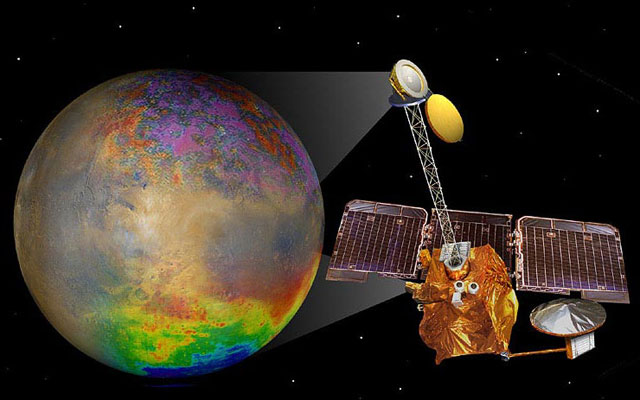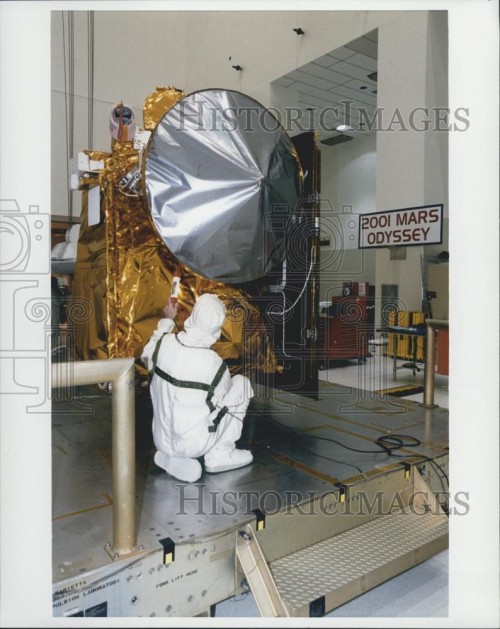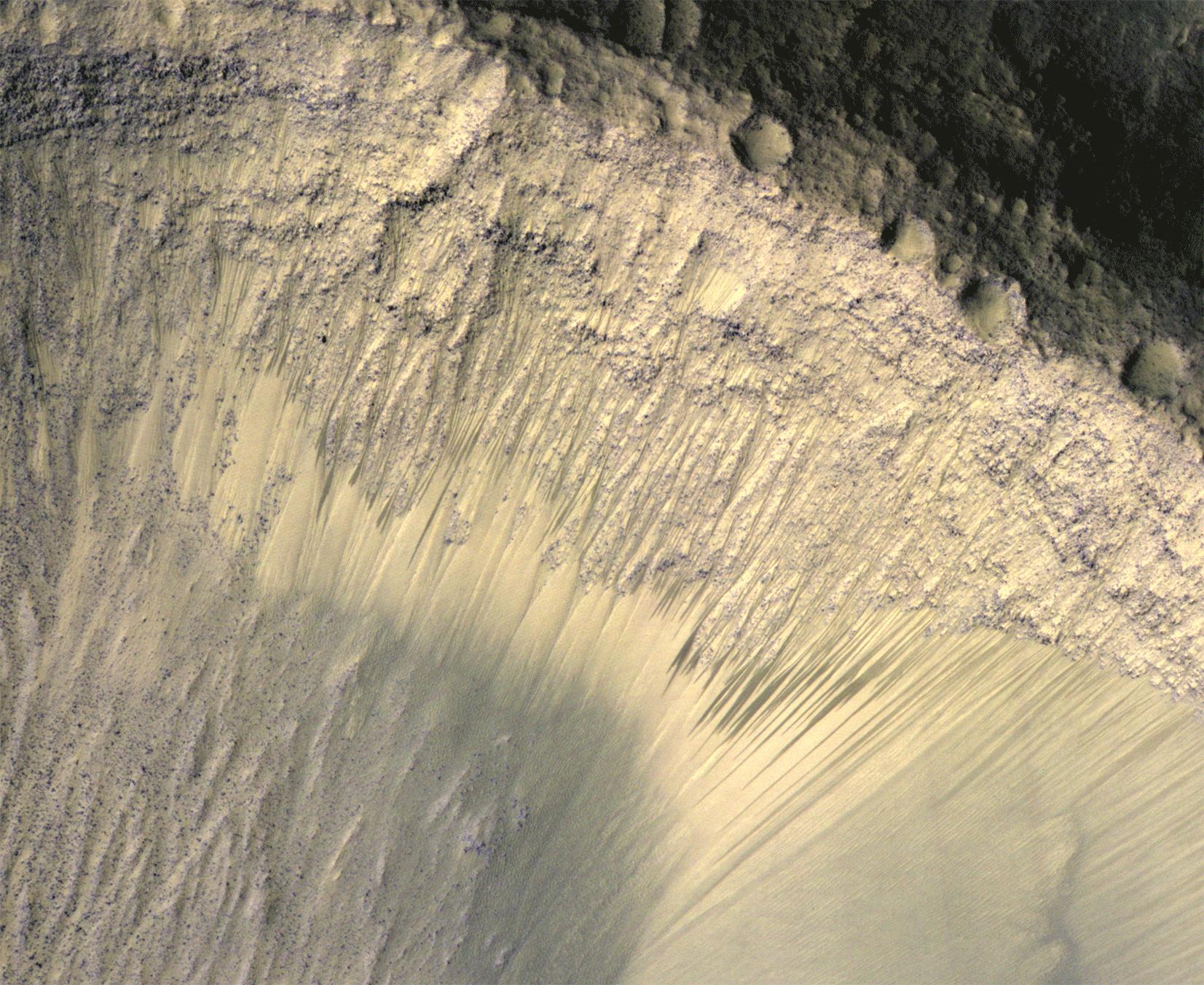
It’s no secret that the various spacecraft NASA sends out across the Solar System on our behalf are the most well-built, durable, and long-lasting vehicles ever constructed in the history of humanity, and today we are reminded of that fact once again with NASA’s Odyssey spacecraft currently orbiting Mars. As of June 23, 2015, Odyssey—named after Arthur C. Clarke’s novel “2001: A Space Odyssey”—has traveled 888 million miles since launching from Cape Canaveral in April 2001, having completed its 60,000th orbit of the Red Planet today, and it is still going strong 14 years after arriving.
Odyssey claimed its place as the longest-operating spacecraft ever sent to Mars several years ago, in December 2010, and shows no signs of giving up its impressive record any time soon. Not only is that great for orbital science observations, but it is great for NASA’s rovers on the ground, too, because Odyssey also serves as a key communications relay for Opportunity and Curiosity. Odyssey has actually transmitted to Earth more than 90 percent of the data received from Opportunity alone, and will serve the same relay duty for other NASA landers in the future, such as InSight, which is scheduled to launch from Vandenberg AFB in March 2016 and arrive at Mars the following September.

“The spacecraft is in good health, with all subsystems functional and with enough propellant for about 10 more years,” said David Lehman, project manager for the Mars Odyssey at NASA’s Jet Propulsion Laboratory (JPL) in Pasadena, Calif.
“This orbital milestone is an opportunity to celebrate Odyssey’s many achievements,” added Jim Green, NASA’s director of Planetary Science. “Odyssey will continue to help lay a foundation for the first humans to Mars in the 2030s through NASA’s Journey to Mars initiative.”
Originally designed to carry out a two-year primary mission, the spacecraft has advanced our knowledge of Mars in many ways. One of the most important being its discovery of plentiful and widespread water ice just below the Red Planet’s surface at higher latitudes, courtesy of its gamma-ray and neutron measurements.
Odyssey has also produced the highest-resolution global map of Mars and has observed in detail seasonal and year-to-year changes on the planet’s surface, such as the freezing and thawing of carbon dioxide. It also monitors radiation in the environment around the planet via the Mars Radiation Environment Experiment, providing data which will serve NASA well as the agency and its many contractors aim to send crews to Mars in the coming decades. (Radiation is one of the biggest health dangers for any human mission beyond the safety of Earth’s magnetic field.)
Looking Ahead
In 2012 Odyssey began a controlled drift for a new orbit, and last year Odyssey fired up its thrusters for a 29-second burn in an attempt to study the planet’s surface during Martian dawn. Doing so will, for the first time in its 13 years of service, give researchers back on Earth a chance to observe possible water processes happening on the ground in morning daylight—something no NASA Mars orbiter has had a chance to do since the twin Viking orbiters in the 1970s.
Other orbiters, from both NASA and the ESA, have observed morning mists, fogs, clouds, and surface frost develop seasonally on the Red Planet, but so far have concentrated on afternoon observation times when views of the surface are less hazy.
Odyssey’s orbit, which is synchronized with the Sun, brings it almost directly over Mars’ north and south poles—every spot it flew over on its dozen daily passes from north to south for its first six years at Mars the local solar time was about 5 p.m. The south-to-north leg of that orbit was at roughly 5 a.m., which provided an advantage for Odyssey’s Gamma Ray Spectrometer to have its cooling equipment pointed away from the Sun while it checked for hydrogen near the Martian surface, which would be evidence for water. The spacecraft adjusted for a 4 p.m. orbit soon after, letting its Thermal Emission Imaging System (THEMIS) take advantage of the mid-afternoon warmth for infrared mineral mapping.
“We don’t know exactly what we’re going to find when we get to an orbit where we see the morning just after sunrise,” said THEMIS Principal Investigator Philip Christensen of Arizona State University. “We can look for seasonal differences. Are fogs more common in winter or spring? We will look systematically. We will observe clouds in visible light and check the temperature of the ground in infrared.”
Christensen proposed letting the time of the orbit shift past 6 p.m., with daylight observations on the south-to-north half of the orbit occurring at about 6:45 a.m. NASA agreed, and Odyssey’s latest maneuver will put the spacecraft where the science team wants it in November 2015.

For several years researchers have also observed, from time to time, what looks like water flows on various slopes as surface temperatures rise. The features, which are typically less than 16 feet wide and no longer than 4,000 feet long, appear on both north-facing and south-facing walls of steep, rocky slopes in spring and summer, then fade as the temperatures drop with the coming of winter. Five well-monitored sites displaying these seasonal features are located in Valles Marineris, which is the largest canyon system in the entire Solar System.
“The equatorial surface region of Mars has been regarded as dry, free of liquid or frozen water, but we may need to rethink that,” said Alfred McEwen of the University of Arizona in Tucson, principal investigator for MRO’s High Resolution Imaging Science Experiment (HiRISE) camera. “The explanation that fits best is salty water is flowing down the slopes when the temperature rises. We still don’t have any definite identification of water at these sites, but there’s nothing that rules it out, either.”
Putting Odyssey into an orbit for morning observations will (hopefully) yield insight about the composition of the ground and about temperature-driven processes, such as water flows and geysers fed by spring thawing of carbon-dioxide ice near Mars’ poles.
Be sure to “Like” AmericaSpace on Facebook and follow us on Twitter: @AmericaSpace





